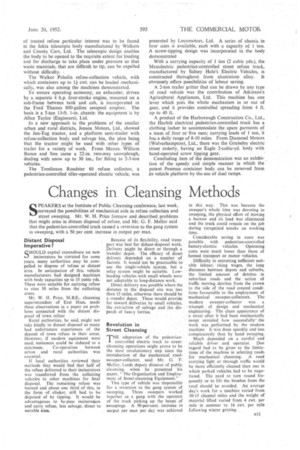Changes in Cleansing Methods
Page 45

If you've noticed an error in this article please click here to report it so we can fix it.
SPEAKERS at the Institute of Public Cleansing conference, last week, surveyed the possibilities of mechanical aids in refuse collection and street sweeping. Mr. W. H. Price foresaw and described problems that might arise in distant disposal of refuse, and Mr. G. F. Mellor said that the pedestrian-controlled truck caused a reversion to the gang system in sweeping, with a 50 per cent. increase in output per man.
Distant Disposal Imperative?
QHOULD capital expenditure on new PN-) incinerators be •retrieted for some years, many authorities may be compelled to dispose of refuse at distant sites. In anticipation of this, vehicle manufacturers had designed machines with body capacities up to 35 cubic yds. These were suitable for carrying refuse to sites 50 miles from the collecting areas.
Mr. W. H. Price, M.B.E., cleansing superintendent of East Ham, made these observations in a paper on problems connected with the distant disposal of town refuse Rural auttibrities, he said, might not take kindly to distant disposal as many had unfortunate experiences of the deposit of town refuse in their areas. However, if modern equipment were used, nuisances could be reduced to a minimum. Co-operation between urban and rural authorities was essential.
If local authorities reviewed their methods they would find that half of the refuse delivered to their incinerators was transferred from the collecting vehicles to other machines for final disposal. The remaining refuse was burned and about one third of this, in the form of clinker, still had to 'be disposed of by tipping. It would be advantageous to by-pass incineration and carry refuse, less salvage,direct to suitable sites.
Because of its flexibility, road transport was best for dietant-disposal work. Delivery might be direct or through a transfer depot. The efficacy of direct delivery depended on a number of factors. It would not he practicable to use the single-vehicle system, but a relay system might be suitable. Lowloading vehicles with small wheels were not adaptable to long-distance work.
Direct delivery was possible where the distance to the disposal site was less than 15 miles, otherwise there should be a transfer depot. These would provide for inward deliveries by small vehicles, the extraction of salvage and the dispatch of heavy lorries.
Revolution in Street Cleansing
THE adaptation of the pedestrian1 controlled electric truck to streetcleansing operations might prove to be the most revolutionary step since the introduction of the mechanical roadsweeper-collector, said Mr. G. F. Mellor, Leeds deputy director of public cleansing. when he presented his 'paper, "The Organization and Employment of Street-cleansing Equipment."
This type of vehicle was responsible for a reversion to the gang system of sweeping. Three sweepers worked together as a gang with the operator of the truck picking up the heaps of sweepings. A 50-per-cent. increase in output per man per day was achieved
in this way. This was because the sweeper's whole time was devoting to sweeping, the physical effort of moving a barrow and its load was eliminated and the truck could remain on the job during recognized breaks on working time.
Considerable saving in costs was possible with pedestrian-controlled battery-electric vehicles. • Operating costs were much lower than those of horsed. transport or motor vehicles.
Difficulty in recruiting sufficient suitable labour, rising ' wages, the long distances between depots and suburbs, the limited amount of detritus in suburban roads and the action of traffic moving detritus from the crown to the side of the road created conditions favourable to the employment of mechanical sweeper-collectors. The modern sweeper-collector was a triumph of design and mechanical engineering. The clean appearance of a street after it_ had been mechanically swept revealed how successfullythe work was performed by the modern machine. It was done speedily and less conspicuously than by hand sweeping. ' Much depended on a careful and reliable driver and operator. Due regard had to be given to the limitations of the machine in selecting roads for mechanical cleansing. A road carrying light or through traffic would be more efficiently cleaned than one in which parked vehicles had to be negotiated. The need to turn round frequently or to lift the brushes from the road should be avoided. An average day's work for a machine varied from 10-15 channel miles and the weight of material lifted varied from 4 cwt. per mile in summer 'to 16 cwt per mile following winter gritting.'




















































































